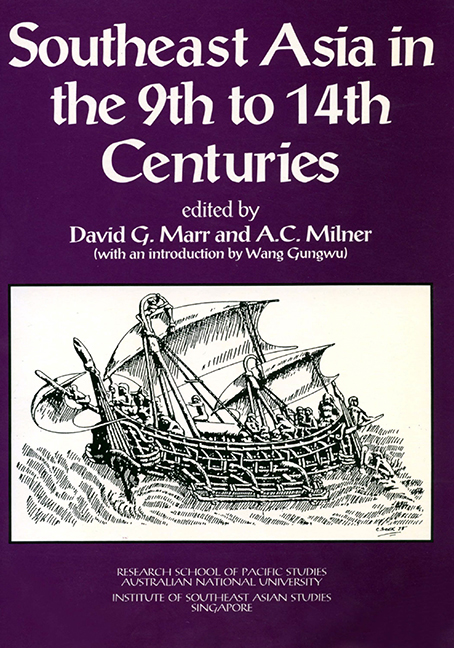Book contents
- Frontmatter
- Contents
- Contributors
- Preface
- Introduction
- 1 The Early and the Imperial Kingdom in Southeast Asian History
- 2 Hydraulic Works and South East Asian Polities
- 3 Some Notes on Relations between Central and Local Government in Ancient Java
- 4 Negara, Mandala, and Despotic State: Images of Early Java
- 5 Some Remarks on Early State Formation in Cambodia
- 6 “Elephants Can Actually Swim”: Contemporary Chinese Views of Late Ly Dai Viet
- 7 Authority and Legitimacy in 11th Century Vietnam
- 8 From Myth to History: Imagined Polities in 14th Century Vietnam
- 9 Shipshape Societies: Boat Symbolism and Political Systems in Insular Southeast Asia
- 10 Changing Perspectives in Island Southeast Asia
- 11 Political and Cultural Continuities at Dvaravati Sites
- 12 The True and the Corbel Arch in Mainland Southeast Asian Monumental Architecture
- 13 Vietnamese Ceramics and Cultural Identity: Evidence from the Ly and Tran Dynasties
- 14 Traditions, Acculturation, Renovation: The Evolutional Pattern of Vietnamese Culture
- 15 Symbolism of Kingship in Arakan
- 16 Buddhism in Champa
- 17 The Ordering of Generations: Change and Continuity in Old Javanese Kinship
- 18 Sources on Economic Activities in Khmer and Cham Lands
- 19 Narrative Bas-Reliefs at Candi Surawana
- 20 Possibilities for a Reading of the 1293-1357 Period in the Vietnamese Annals
- Index
- Miscellaneous Endmatter
13 - Vietnamese Ceramics and Cultural Identity: Evidence from the Ly and Tran Dynasties
Published online by Cambridge University Press: 21 October 2015
- Frontmatter
- Contents
- Contributors
- Preface
- Introduction
- 1 The Early and the Imperial Kingdom in Southeast Asian History
- 2 Hydraulic Works and South East Asian Polities
- 3 Some Notes on Relations between Central and Local Government in Ancient Java
- 4 Negara, Mandala, and Despotic State: Images of Early Java
- 5 Some Remarks on Early State Formation in Cambodia
- 6 “Elephants Can Actually Swim”: Contemporary Chinese Views of Late Ly Dai Viet
- 7 Authority and Legitimacy in 11th Century Vietnam
- 8 From Myth to History: Imagined Polities in 14th Century Vietnam
- 9 Shipshape Societies: Boat Symbolism and Political Systems in Insular Southeast Asia
- 10 Changing Perspectives in Island Southeast Asia
- 11 Political and Cultural Continuities at Dvaravati Sites
- 12 The True and the Corbel Arch in Mainland Southeast Asian Monumental Architecture
- 13 Vietnamese Ceramics and Cultural Identity: Evidence from the Ly and Tran Dynasties
- 14 Traditions, Acculturation, Renovation: The Evolutional Pattern of Vietnamese Culture
- 15 Symbolism of Kingship in Arakan
- 16 Buddhism in Champa
- 17 The Ordering of Generations: Change and Continuity in Old Javanese Kinship
- 18 Sources on Economic Activities in Khmer and Cham Lands
- 19 Narrative Bas-Reliefs at Candi Surawana
- 20 Possibilities for a Reading of the 1293-1357 Period in the Vietnamese Annals
- Index
- Miscellaneous Endmatter
Summary
Introduction
The glazed ceramics of Vietnam represent the most sustained and sophisticated expression of the potter's art in Southeast Asia and yet they are perhaps the least understood of those traditions. The lack of critical enquiry into the distinctive character of Vietnamese ceramics has been the product of a tendency to view them, along with other aspects of Vietnamese cultural expression, as a “curious provincialism”,[1] a pale reflection of Chinese culture. The history of Vietnamese ceramics does, broadly speaking, parallel the evolution of Chinese ceramics from the Han period onwards in respect of form and style. It is equally true however that the Vietnamese potter gave expression to elements of cultural identity which are essentially Vietnamese. This is to be seen in the distinctive manipulation of ceramic forms and, more significantly, in the expansion of the decorative repertoire to incorporate motifs and design elements unknown in the Chinese tradition. Moreover, the many motifs which were borrowed were reinterpreted with a confidence and sophistication which often produced results instilled with a freshness and energy unmatched in the Chinese originals. In this paper I wish to examine the decorative repertoire of ceramic design during the Lý and Trân dynasties, 11th to 14th centuries, and to argue that the choice and interpretation of motifs seen on the ceramic products of this period constitute conscious statements of Vietnamese cultural identity.
The evolution of glazed ceramics in Vietnam reflects the shifting requirements of Vietnamese society over time. The earliest wares were produced in response to the needs of sinicized elements of Vietnamese society which appeared during the Han occupation in the 1st and 2nd centuries A.D. These vessels, which have been excavated from Han tombs of fired brick, parallel the funerary goods of Han China. Current evidence points to the Red River delta region and the province of Thanh Hoa, immediately to the south, as the principal regions for early production of ceramics in Vietnam. By the mid 3rd century A.D. the Red River delta was already supporting the bulk of the population of Tonkin, a pattern which persists today.[2] A lacuna exists in the ceramic evidence from the collapse of direct Han control in the 3rd century A.D. through until the beginning of the 10th century.
- Type
- Chapter
- Information
- Southeast Asia in the 9th to 14th Centuries , pp. 255 - 270Publisher: ISEAS–Yusof Ishak InstitutePrint publication year: 1986



